Introduction
- Books Name
- CBSE Class 6 Science Book
- Publication
- Param Publication
- Course
- CBSE Class 6
- Subject
- Science
Introduction
Food is one of the most basic requirements of life. Food supplies us with energy. It is also required for growth and maintenance of the body. It also protects us from diseases.
Components of food
Food contain various chemical substances required by our body. These chemical substances are called nutrients. Our body needs some of these nutrients in larger quantities ad some in only very small quantity.
These nutrients can be broadly grouped into the following seven classes.
1. Carbohydrates 2. Fats 3. Proteins 4. Vitamins
5. Minerals 6. Water 7. Roughage
Balanced Diet
• A balanced diet is one which provides proper amount and proportion of fats, carbohydrates, proteins, vitamins and minerals, needed for the growth and maintenance of the body. A balanced diet should have three main qualities :
1. It should be rich in essential nutrients like minerals and vitamins.
2. It should provide the exact amount of raw materials needed for growth, development, repair and replacement of body tissues.
3. It should provide the right amount of energy required by the body.
Classification of food
• Food can be classified under three different categories on the basis of its functions:
(i) Energy giving food : Carbohydrates and fats, eg. cereals, sugars, oils, etc.
(ii) Body building food : Proteins, minerals and fats, eg. pulses, beans, milk, fish, etc.
(iii) Protective food : Vitamins & minerals, eg. vegetables, fruits, milk, etc.
What do Different Food Items Contain?
- Books Name
- CBSE Class 6 Science Book
- Publication
- Param Publication
- Course
- CBSE Class 6
- Subject
- Science
Basic constituents of food
(a) Carbohydrates :
Carbohydrates are organic compounds of carbon, hydrogen and oxygen.
• They are the main source of energy in our body.
• One gram of carbohydrate yields about 4 kilocalories of heat energy.
• A major portion of our food consists of carbohydrates, e.g., rice, chapatis.
• If excess amount of carbohydrates are present in the body, they are converted into fats and stored under the skin and around various organs of the body.
• The carbohydrates in our food are obtained mainly from the plant sources like wheat, rice, maize, potato etc.
• Starch and sugars are the two carbohydrates which provide most of the energy to our body.
(b) Fats :
• Fats are composed of carbon, hydrogen and oxygen.
• They have a lower oxygen content than carbohydrates.
• They are very important sources of energy.
• One gram of fat yields 9 kilocalories of energy.
• A layer of fat under the skin helps to reduce the amount of heat loss from the body in cold weather conditions.
• Every fat molecule consists of three molecules of fatty acids and one molecule of glycerol.
• Fats are insoluble in water but soluble in organic solvents like alcohol, ether, benzene, etc.
• Fats are supplied to our body by different foods like butter, ghee, cheese, ground-nut etc. All the cooking oils (like ground-nut oil, coconut oil) provide us fats.
• Fats also help in forming of cell membranes and other organelles.
• They help in transportation of fat-soluble vitamins in our body.
(c) Proteins :
The name protein was coined by Berzelius in 1838.
• Chemically proteins are polymers of molecular units called as amino acids.
• The amino acids are linked together by a peptide bonds. There are about 20 amino acids that take part in the formation of proteins. The 20 amino acids are further divided into two groups :
• Essential amino acids : They are 10 in number. They are not synthesized in a human body and are obtained from food so they are called as essential amino acids. e.g., Methionine, Leucine and tryptophan.
• Non – essential amino acids : They are also 10 in number. They are synthesized in a human body & are thus termed as non – essential amino acids. e.g., Alanine, Asparagine, Aspartic acid and cystine.
• Pulses, peas, beans, nuts, cheese, milk are the important sources of proteins.
• They act as a structural components of cell. They are essential for growth and repair of the body.
• They help to catalyse various reactions occuring in our body.
• They play important roles as hormones, antibodies, etc.
• All the enzymes are made up of proteins.
• Haemoglobin, the respiratory pigment of animals is a conjugated protein composed of globin and haem(pigment).
(d) Vitamins :
Vitamins are organic compounds essential for the growth of the body. They are required by the body in very small quantities. Vitamins are classified into two types.
(A) Fat soluble Vitamins A, D, E, K. (B) Water soluble Vitamins B and C.
• These are obtained from fruits, cod liver etc.
• They keep the body healthy and prevent it from diseases. If the diet does not contain the required amount of vitamins, it results in vitamin deficiency diseases.
(e) Minerals :
• Human body requires about fifteen different kinds of minerals, e.g.-
• Calcium and phosphorus are needed for the growth of bones and teeth.
• Iron is needed for the formation of haemoglobin in blood.
• Iodine, sodium, potassium and zinc are necessary for a good healthy body.
• Meat, eggs, milk, green vegetables and fruits are rich in minerals.
• Minerals are required by the body in trace amounts and are essential for growth, repair and replacement processes. They form a major part of many body chemicals and tissues.
(f) Roughage :
Cellulose forms the fibre content in food and that fibre content is called roughage. Roughage keeps the digestive system in good working condition.
• It is a plant fibre found in vegetables, fruits, peas, beans, maize and in the barn which surrounds wheat grains.
• It absorbs water and poisonous waste from food during digestion. Food without roughage forms hard dry lumps of waste which get stuck in the gut causing constipation.
(g) Water :
The human body contains 70 % of water. It has no food value but it is still one of the essential components of living matter.
• Water performs the following functions in our body :
• It transports food materials within the body.
• It helps in the formation of urine and faeces.
• It regulates the body temperature.
• It is an essential part of blood and digestive juices.
What do Different Food Items Contain?
- Books Name
- Class 6 Science Book
- Publication
- PathSet Publications
- Course
- CBSE Class 6
- Subject
- Science
INTRODUCTION
What do different Food Items contain?
- All living organisms such as plants and animals require food. So, food is essential for all living organisms.
- The food that we eat consists of different components or nutrients.
- NUTRIENTS are required for proper growth and healthy body function.
- The process by which we obtain food and utilize it for growth and development is called nutrition.
- Carbohydrates, proteins, fats, vitamins and minerals are essential components of food, these components are called nutrients.
- In addition, food also contains dietary fibers and waters
Nutrients: A nutrient can be defined as components that are needed by our body to grow, survive and carry on different daily activities.
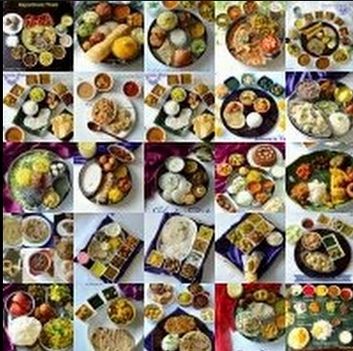
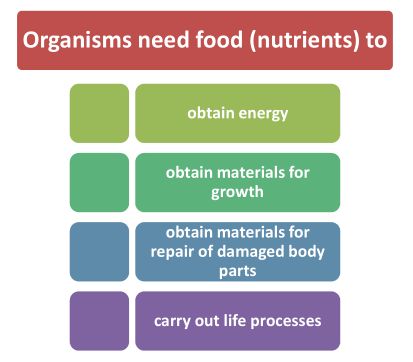
Different Type of Food
Energy-giving food
Carbohydrates and Fats. Carbohydrates provide us instant energy. Fats are stored energy resources
Body-building food
Proteins are body-building food as they help in body growth and repair of damaged parts of the body.
Protective food
Vitamins and minerals are protective food as they protect us from many diseases. They give us resistance against disease causing germ
- Our food contains mainly five major kinds of nutrients namely vitamins, minerals, carbohydrates, proteins and fats. Additionally, food also contains water and dietary fibers/roughage and water which are also required by our bodies.
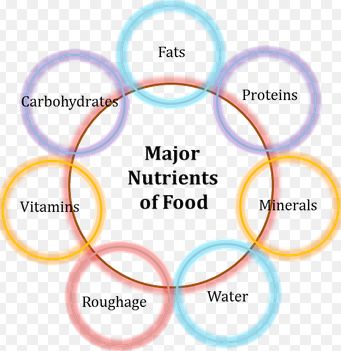
Fig. 1: Major nutrients of food
What do Various Nutrients do For Our Body?
- Books Name
- CBSE Class 6 Science Book
- Publication
- Param Publication
- Course
- CBSE Class 6
- Subject
- Science
Test For Carbohydrates, Fats & Proteins
(a) Test for carbohydrates :
Take few drops of iodine solution & add it into boiled rice or potato. The formation of blue-black colour confirms the presence of starch (carbohydrate).
(b) Test for fats :
When ghee / butter rubbed on white paper, that portion of paper turns translucent indicating the presence of fats.
(c) Test for proteins :
Take the few drops of egg albumin in a test tube and add a few drops of concentrated nitric acid to it.
• The white colour of the albumin changes to yellow. Now, pour the acid out of the test tube but keep the white of the egg in the test tube.
• Add a few drops of ammonium hydroxide to it.
• The colour changes to violet which shows the presence of proteins.
What do Various Nutrients do For Our Body?
- Books Name
- Class 6 Science Book
- Publication
- PathSet Publications
- Course
- CBSE Class 6
- Subject
- Science
What do Various Nutrients do for Our Body?
Carbohydrates
- Provides energy to our body.
- There are two types of carbohydrates: SUGAR and STARCH
- SUGAR: it is called SIMPLE carbohydrates. Source: fruits, honey, and table sugar
- STARCH: it is called COMPLEX carbohydrate. Plants store energy in the form of starch. Source: Rice, wheat, corn, potato, and bread.
- If after adding iodine to the food, the food turns into blue-black colour, then it indicates that it contains starch.
- In our digestive system sugar and starch are broken down into glucose by various enzymes (substance produced by a living organism which helps to bring about a specific biochemical reaction)
- GLUCOSE is the SIMPLEST form of Carbohydrates
- It is then absorbed into the blood and provides us energy.
Fats
- Provides energy to our body.
- Fats are the slowest source of energy but the most energy-efficient form of food.
- Each gram of fat supplies the body with calories, more than twice that supplied by equal amount of proteins or carbohydrates.
- Food containing both carbohydrates and fat are called ‘ENERGY GIVING FOODS’
- There are of two types of FAT: SATURATED and UNSATURATED.
- SATURATED: Normally Solid at room temperature. E.g. butter and ghee.
- UNSATURATED: Normally Liquid at room temperature. E.g., vegetable oil
- There are generally two types of source of fat : Plant & Animal
- Plant source: ground nut oil, Mustard oil, Sunflower oil, Coconut oil, Cashew, Soyabean
- Animal source: Butter, ghee, milk, cheese, egg yolk, Meat, fish.
- Excess body fat leads to a condition called Obesity. Obesity may lead to heart diseases.
- Proteins
- Protein is needed for growth and repair of our body.
- Food containing proteins are called ‘BODY BUILDING FOODS’
- Children require more protein because of the rapid growth of their body.
- Our Muscles, organs even bloods are made up of mostly proteins.
- There are generally two types of source of Protein: Plant & Animal
- Plant source: peas, soybeans, groundnut,
- Animal source: Milk, cheese, fish, meat, chicken, eggs
- Protein rich food -> put it in test tube and add some water -> heat the test tube for 1 min -> let it cool, then add two drops of COPPER SULPHATE solution and SODIUM HYDROXIDE -> turn PURPLE /VIOLET to confirm presence of Protein.
Vitamins
- For proper functioning of our body we need vitamins in our diet.
- Vitamins keep us healthy.
- There are about 20 vitamins
- Vitamins are of two types: FAT-SOLUBLE and WATER – SOLUBLE.
- FAT- SOLUBLE: A, D, E, K Stored in fat tissues of our body.
- Our body prepares vitamin D in the presence of sunlight.
- WATER – SOLUBLE: B1, B2, B3, B6, B12, FOLIC ACID & VITAMIN C Not stored in body, so regular intake is necessary.
- Minerals: Minerals are used by the body to perform various functions like building strong bones, maintaining the heartbeat, making hormones etc. The major five minerals are Calcium, Phosphorus, Magnesium, Sodium and Potassium. Examples of mineral-rich foods include leafy vegetables, fish, beans etc.
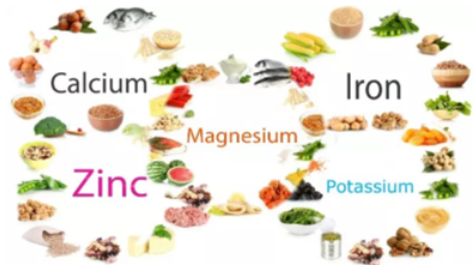
Fig.3: The five major minerals and their source foods
- Dietary Fibers/Roughage: While dietary fibers do not provide any such nutrition to our bodies but nevertheless are an important component of food. They help in easy absorption of food, helps in movement of bowel and prevents constipation. It helps our body get rid of undigested food. Cereals, fruits and vegetables are some of the roughage rich foods.
- Water: Water performs the essential function of absorbing nutrients from our food. It also helps in releasing waste from our body in form of sweat and urine.
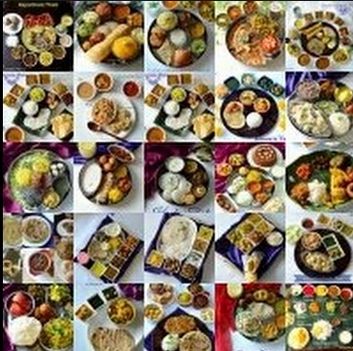
- Our food contains mainly five major kinds of nutrients namely vitamins, minerals, carbohydrates, proteins and fats. Additionally, food also contains water and dietary fibres/roughage and water which are also required by our bodies.
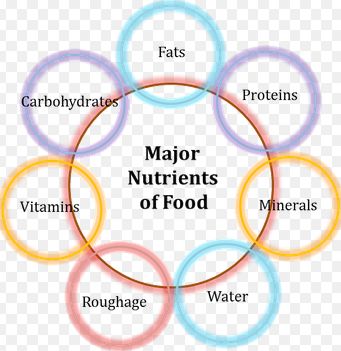
Fig. 1: Major nutrients of food
Carbohydrates: Carbohydrates main function is providing energy to the body. These are found in our food in the form of sugar and starch i.e. simple and complex carbohydrates. Example It is found in bread, potatoes etc.
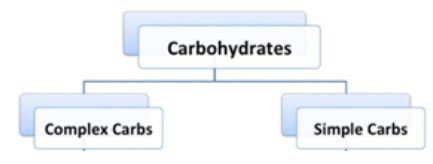
Fig.2: The Two Types of Carbohydrate
Simple Carbohydrates: These are also referred to as simple sugars, containing single monosaccharide units and found in natural sources of food i.e. milk, fruits and vegetables. These carbohydrates add certain sweetness to the food. They raise the level of blood glucose quickly but are easier to break down.
Complex Carbohydrates: These are also referred to as polysaccharides, meaning they contain hundreds or thousands of such monosaccharide units. These are typically found in wheat grain, white bread, kernel and cakes. They are relatively less sweet than simple carbohydrates and also raise blood glucose level rather slowly. However, these are tougher to break down. Cellulose is present in plant cell wall. It is a complex carbohydrate. Humans cannot digest cellulose.
Test for carbohydrates: We can test whether a particular food item contains carbohydrates by pouring 2 to 3 drops of dilute iodine solution on it. If the iodine changes its colour to blue-black, then we can ascertain that the food item does, in fact, contain carbohydrates.
Proteins: Proteins performs the very essential function of helping our body grow and repair itself. These are found in food items such as milk, pulses, eggs, meat etc. Foods containing proteins are called ‘body-building’ foods.
Test for proteins: To test whether a food item contains proteins, first we need to grind it into a paste or powder form and add 10 drops of water. To this mixture when we add 2 drops of copper sulphate solution and 10 drops of caustic soda solution. After a few minutes, if the mixture turns violet, it is indicative of the presence of protein.
Fats: Fats are also responsible for providing energy to our body. In fact, they provide more energy than carbohydrates. The body uses fat as a fuel source. Fats are essential for the absorption of vitamins A, D, E and K in the body. Butter, cheese, oil are all examples of fat-rich foods.
Test for fats: To test for fats, take a small quantity of food item and wrap a piece of paper around it and proceed to crush it. After removing the paper, allow it to dry. If you see a film of an oily patch on the paper when holding it against light, it is proof that the food contains fats.
Vitamins: Vitamins help in protecting our bodies from various kinds of diseases. They also help in keeping our eyes, gums, bones and teeth in good shape. Different types of vitamins and their uses:
Minerals: Minerals are used by the body to perform various functions like building strong bones, maintaining the heartbeat, making hormones etc. The major five minerals are Calcium, Phosphorus, Magnesium, Sodium and Potassium. Examples of mineral-rich foods include leafy vegetables, fish, beans etc.
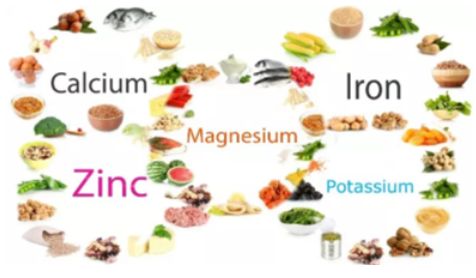
Fig.3: The five major minerals and their source foods
Dietary Fibers/Roughage: While dietary fibers do not provide any such nutrition to our bodies but nevertheless are an important component of food. They help in easy absorption of food, helps in movement of bowel and prevents constipation. It helps our body get rid of undigested food. Cereals, fruits and vegetables are some of the roughage rich foods.
Water: Water performs the essential function of absorbing nutrients from our food. It also helps in releasing waste from our body in form of sweat and urine
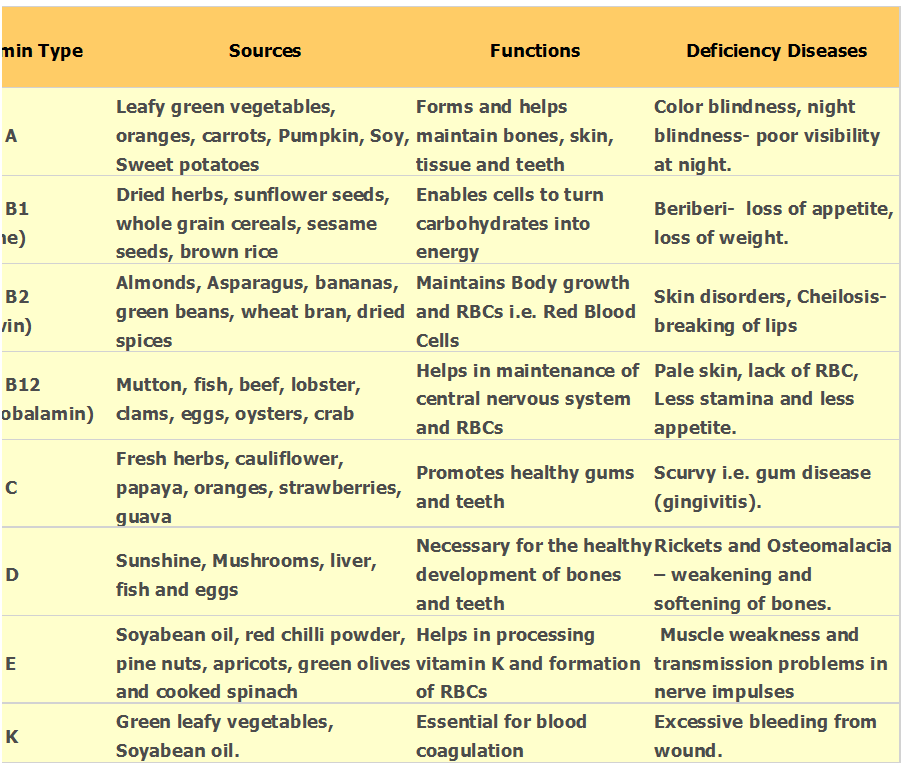
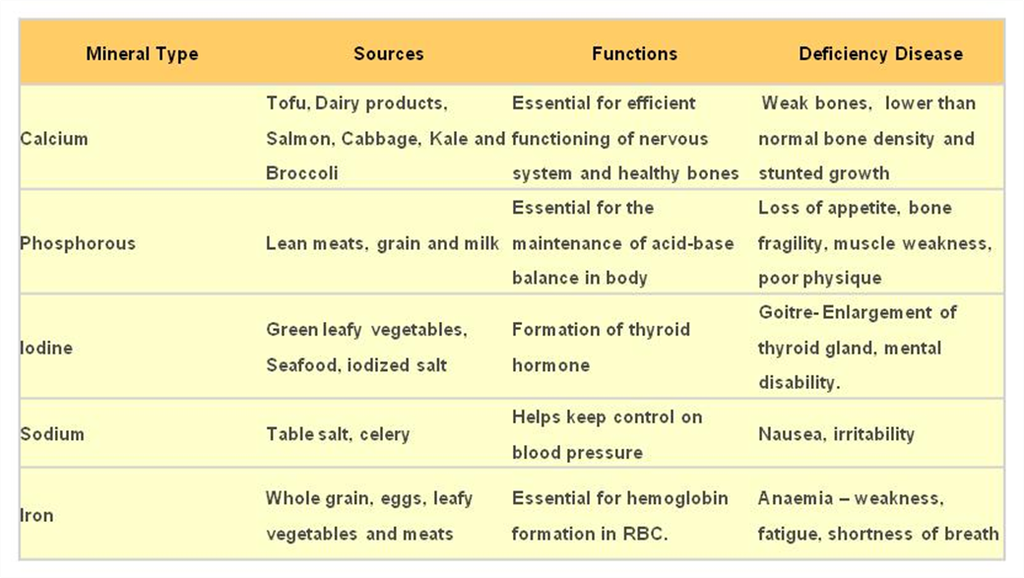
Summary
Carbohydrates and Fats
Carbohydrates in our food are mainly sugar, starch.
Starch is present in grains like rice, wheat, maize, tubers like potatoes etc.
Sugar is the sweet substance. Common sugar we use is Sucrose and it is obtained from Sugar cane
Fats are stored energy resource. Animal sources include milk, butter, ghee, cheese and meat and Plants resources like oil are rich resources of fats
Proteins
Proteins are body-building food as they help in body growth and repair of damaged parts of the body.
Animal sources like eggs, fish, meat, milk, cheese and Plant sources like pulses of beans are resource of proteins
Proteins are broken-down by the digestive system into amino acids (which can be absorbed into the blood).
Vitamins and Minerals
Vitamins are protective food as they protect us from many diseases. They give us resistance against disease causing germ
Vitamins are A, B, C.D, K, E. They are obtained from Fruits, vegetables, fish liver oil, milk, eggs,
Minerals are also required in small quantities. Minerals include sodium, Calcium, Potassium, iodine and phosphorous
Balanced Diet
- Books Name
- CBSE Class 6 Science Book
- Publication
- Param Publication
- Course
- CBSE Class 6
- Subject
- Science
Deficiency Diseases
The main cause of deficiency diseases in our country is poverty. A vast majority of our people are not able to buy quality food items in desired quantities.In the long run they become weak and sick.Its effect on children is more serious.
Diseases due to Deficiency of Carbohydrates:
Carbohydrates are the chief sources of energy for the body. This energy is used by the body for performing various functions.
Deficiency of sufficient carbohydrates in the diet leads to (i) body weakness, and (ii) loss of stamina, as sufficient quantity of energy is not available to the body for performing various functions.
Diseases due to deficiency of Protein :
Proteins are body-building food and causes serious diseases, like kwashiorkor and marasmus develop in case of children if the proteins are not sufficient in their diet. It is for this reason that the children are often advised to take a protein-rich diet – enough milk, pulses, eggs, meat and fish,
• Symptoms of Kwashiorkor
(i) Protruding belly
(ii) Dark and scaly skin, brownish hair
(iii) Stunted growth ; usually underweight
(iv) Swollen legs due to accoumulation of water
(v) Loss of appetite
(vi) Anaemia
(vii) Mental retardation
(viii) Reduced resistance to diseases
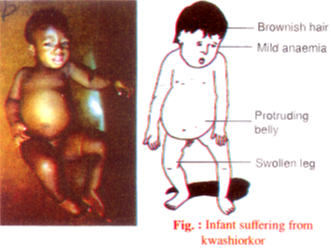
Balanced Diet
- Books Name
- Class 6 Science Book
- Publication
- PathSet Publications
- Course
- CBSE Class 6
- Subject
- Science
What is Balanced Diet?
A balanced diet is food intake that includes all the dietary needs of the organism in the correct proportions.
Balanced diet comprises the components like carbohydrates, proteins, fats, vitamins, minerals and enough water. Balanced diet keeps our body fit and resistant to diseases.
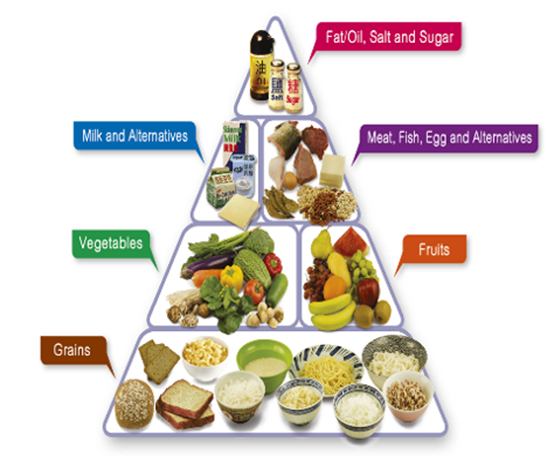
Balanced Diet
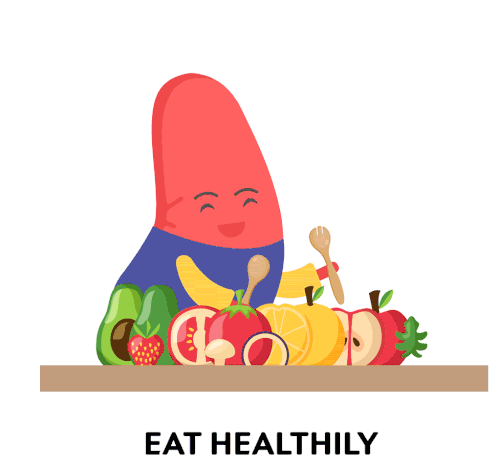
A balanced diet is one that contains a variety of food items providing different types of nutrients in adequate amounts necessary for maintaining good health. The diet should contain a good amount of dietary fiber and water as well.
A balanced diet includes a combination of protein-rich pulses, sprouted seeds etc. with combinations of various flours and cereals for carbohydrates and fats along with fruits and vegetables which provide the necessary vitamins and minerals.
- In addition to making sure that the right amount of food is eaten, it should also be ensured that food is properly cooked so that it does not end up losing its nutrients.
- Repeated washing of fruits, pulses, rice and vegetables can result in the loss of essential vitamins and minerals.
- Throwing away excess water which is used for cooking vegetables can result in the loss of considerable amounts of important proteins and minerals present in them.
- It’s a well-known fact that vitamin C gets destroyed in the heat while cooking.
Obesity: Obesity is a medical condition that results from excess intake of fat-rich foods. The excess fat gets accumulated to such an extent that it starts negatively affecting one’s health, well-being and the ability to carry out certain activities.
Deficiency Diseases
- Books Name
- CBSE Class 6 Science Book
- Publication
- Param Publication
- Course
- CBSE Class 6
- Subject
- Science
• Symptoms of Marasmus
(i) Poor muscle development
(ii) Bones showing through the skin ; no fat
(iii) Weak legs
(iv) Loss of appetite
(v) Anaemia
(vi) Grossly underweight
(vii) Mental retardation
(viii) Reduced resistance to diseases
Protein Energy Malnutrition (PEM) is a term used to describe diets which lack proteins and energy - giving carbohydreates.Diseases caused by PEM are common among children.
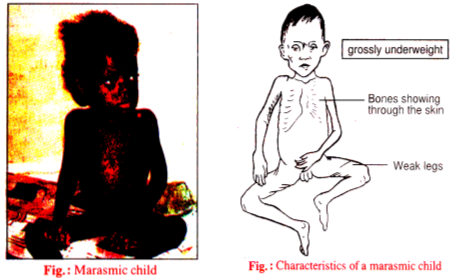
• Kwashiorkor and marasmus are diseases which result from PEM.
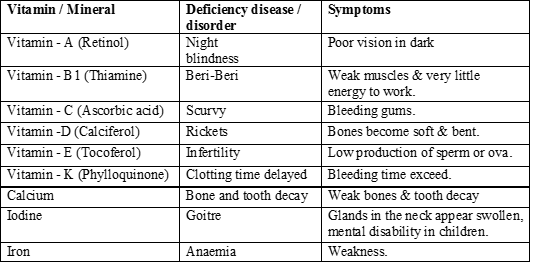
Deficiency Diseases
- Books Name
- Class 6 Science Book
- Publication
- PathSet Publications
- Course
- CBSE Class 6
- Subject
- Science
Deficiency Diseases
Deficiency Diseases
Deficiency: Sometimes simply getting adequate amounts of food might not be enough if the food does not contain the required nutrients in the right amounts. Prolonged usage of such nutrient-less food may result in a condition known as Deficiency.
Deficiency Diseases: Diseases that occur from the lack of an element in the diet, usually a particular vitamin or mineral are known as deficiency diseases.
Diseases that occur due to lack of nutrients over a long period are called deficiency diseases
- Deficiency of carbohydrates causes lack of energy and stamina.
- Deficiency of proteins causes kwashiorkor whereas combined deficiency of proteins and carbohydrates causes marasmus.
- Deficiency of vitamins can cause night blindness, beriberi, anemia, scurvy, and rickets.
- Deficiency of water can cause dehydration.
- Deficiency of minerals can cause osteoporosis, rickets, anaemia, and goitre
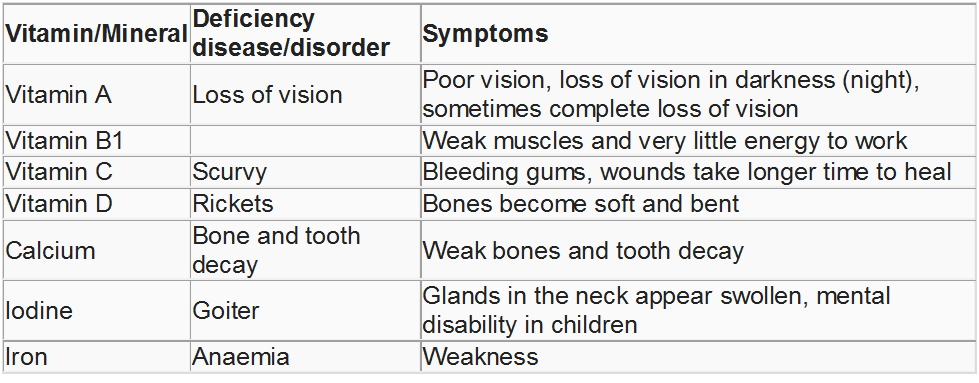
- A diet lacking proteins may result in skin diseases, stunted growth, diarrhoea, swelling of face and discolouration of hair.
- A diet deficient in both carbohydrates and protein may hinder the growth completely and the person becomes so frail and lean that he or she might not even be able to move.
- Deficiency of certain vitamins and minerals can cause diseases like scurvy, goitre, anaemia etc. as mentioned in the tables above.
Hence one must always make sure to include all nutrients in their food and drink a good amount of water to maintain a healthy body that is free from diseases.
Malnutrition
Improper intake of nutrient-rich food may lead to another condition called malnutrition or undernutrition. Without adequate intake of food, our bones become brittle, our muscles weaken and our thinking becomes foggy. In such situations, our bodies are said to become malnourished.
When there is lack of protein in our bodies, repair of wounds and an injury becomes difficult. When this is combined with inadequate intake of calories, it leads to a condition known as Protein-energy Undernutrition or malnutrition.
There are two ways in which protein-energy malnutrition manifests itself:
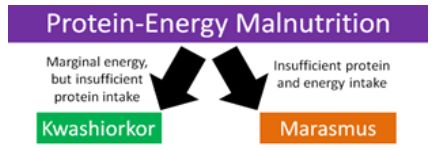
Fig.4: Two types of protein-energy malnutrition diseases
Kwashiorkor: People with severe protein deficiency are often at high risk of developing this disease. People in rural areas are more likely to suffer from this disease, as there is lack of protein rich food. If one often indulges in diets that are high on carbohydrates and low on protein it can lead to them showing symptoms of kwashiorkor i.e. Edema (puffy appearance due to retention of fluid), inability to gain weight and bulging of abdomen.
Marasmus: Children and young adults are more likely to develop this disease. If there is inadequate intake of both energy and protein, it tends to manifest as marasmus. Chronic diarrhoea, weight loss, dehydration and stomach shrinkage are the major symptoms of marasmus.
GOOD COOKING HABITS:
- Overheating, overcooking destroys nutrients and add extra calories at times.
- Vitamin C is destroyed due to overheating.
- Use of excess water is not desirable.
- Washing of rice and pulses repeatedly removes nutrients.
- Vegetables and fruits should be washed before cutting

 Param Publication
Param Publication
 PathSet Publications
PathSet Publications
